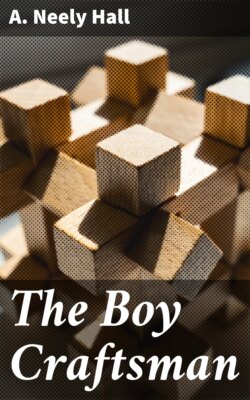Читать книгу The Boy Craftsman - A. Neely Hall - Страница 9
На сайте Литреса книга снята с продажи.
Laying out Work
ОглавлениеA two-foot carpenter's folding-rule should generally be used in laying off measurements and a sharp-pointed pencil or brad-awl to locate the points. To connect the points it is necessary to have a straight-edge—a steel framing-square (Fig. 42) for large boards and a small try-square (Fig. 38) for smaller pieces—and a pencil or knife.
Figs. 38–39.
A pencil may be used in connecting points upon rough work, but for greater accuracy a knife should be used, as it makes a thinner and cleaner-cut line. In making knife lines, the square must be held very firmly, to prevent it from slipping and allowing the knife to run out of its course.
To draw lines across a board at right angles to one edge (which should be the straight or "tried edge" of the board) with the steel-square, place one arm of the square parallel with the tried edge and mark along the other arm. To perform the same operation with the try-square, place the handle against the tried edge, as shown in Fig. 38.
Oftentimes it becomes necessary to draw a line parallel to the tried edge. This may be done roughly with the rule and pencil, as shown in Fig. 40. Grasp the rule in the left hand, with the first finger touching the tried edge of the board, and hold the pencil point against the end of the rule with the right hand. Keeping this position, with a steady hold on the rule and pencil, move your hands along the board. The result will be a line parallel to the tried edge.
At first you may have trouble in making a straight line, but with practice you will be able to hold the rule and pencil steadily.
Fig. 40.—Gauging with Rule and Pencil.
For particular work, where it is necessary to get a perfectly straight and parallel line,
A Marking-gauge should be used. This is nothing more than the above principles combined in a tool. It consists of a graduated shaft, or rule, with a small needle or spur in one end, which slides through a mortise made in a block of wood known as the head.
Fig. 41.—Using the Marking-gauge.
To operate the gauge, set the adjustable head at the required division on the shaft, and then grasp the head and shaft with the fingers of the right hand, as shown in Fig. 41. Place the outer face of the head against the tried edge of your work, and then, pressing the spur into the wood, move the gauge along the board, at the same time keeping the face of the head firmly against the edge of the board. The gauge is much more convenient than the other method of drawing parallel lines, for you can repeat the measurement as often as you wish, having once adjusted the head, without having to lay it off again.
A Try-square with a mitred handle costs but little more than the ordinary make, and is much handier, inasmuch as it can be employed in making mitres, by placing the bevelled end against the side of the work instead of the straight side (see Figs. 38 and 39).
Fig. 42.
The Bevel is in reality a try-square which can be adjusted to any desired angle. To set it at an angle of forty-five degrees, place it on the steel-square, as shown in Fig. 42, with the handle against the inner edge of one arm of the square and the blade resting on both arms. Move the blade until it strikes equal distances on the arms (this is shown at four inches in the drawing) and tighten the screw while it is in this position. Other angles may be drawn out upon a piece of wood and the bevel adjusted to them so these angles can be laid off upon other pieces. You will find the bevel handy for reproducing angles. However, if you are supplied with a mitred try-square you can easily dispense with it for ordinary work.
There will be times when you wish
To Divide a Board into a number of equal parts, which may be found to be fractions of an inch that cannot be easily laid off with the rule in the ordinary way. It can be accomplished with a pair of compasses, but until you become practised in their use, it will take some little time in setting them, dividing, resetting, and redividing, until the exact divisor is obtained. A much quicker method is that performed with the rule, as shown in Fig. 43.
Suppose you wish to divide a board four and three-quarters inches long into five equal parts. Place your rule across the board, as shown in the illustration, one end at one edge and the "five-inch" division at the opposite edge. Mark off the five divisions and then square the lines across the board at these points with the try-square. This will give you the required five equal parts.
Fig. 43.—Dividing a Board Equally.
In the same way longer boards may be divided up by using two-and three-inch divisions on the rule instead of one-inch, and smaller pieces by using half-and quarter-inch divisions.
